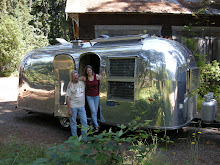 Glancing off to the side of the road as we meandered down Highway 12 in SE Washington State, we caught a brief glimpse of a large old wooden structure with the fading sign “Pataha Flour Mill” painted on its side. Managing a quick right turn at the next intersection (no small feat when pulling a 22’Airstream), we motored in across a small wooden bridge and made our way to the gravel parking lot.
Glancing off to the side of the road as we meandered down Highway 12 in SE Washington State, we caught a brief glimpse of a large old wooden structure with the fading sign “Pataha Flour Mill” painted on its side. Managing a quick right turn at the next intersection (no small feat when pulling a 22’Airstream), we motored in across a small wooden bridge and made our way to the gravel parking lot.Up close, this was an imposing structure and was over five stories tall to accommodate the machinery, chutes and storage bins needed to process the grain. As we entered through the front doors we found that it now housed a restaurant. After hearing that we “just wanted to see the building” the nice young man at the front counter headed toward the back and said “let me show you the museum!”
Pushing through the wooden saloon style doors, he invited us to have a look around and be careful on the ramps. And look we did. Immediately in front of us stood the largest collection of vintage cameras we have ever seen. There were hundreds of cameras, of every type and vintage, and ranging in size from the smallest handheld to large format portrait cameras. Every one seemed in almost new condition and the scope of the collection was both unexpected and staggering.
From there it was on to what a small sign declared to be Delbert Neibel’s Branding Iron collection. While not as large as the camera collection, we can honestly say that we have never seen a larger branding iron collection, or any branding iron collection for that matter! Each one was carefully translated from Cowboy to English (S Bar S, Rocking Y Ranch, etc.) for the novice Branding Iron Museum visitor. One left the room knowing that somewhere, Delbert Neibel was smiling.
Next we began to climb a series of steep and narrow wooden ramps that led up through the various floors of the mill. As there was minimal powered equipment available at the time, the mill relied a lot on gravity to move the grain through the process of sorting, grinding, sifting and finally bagging the finished product of flour. Huge, largely wooden machines powered by leather belts strung throughout the building did most of this work and the ingenuity of the machinery was impressive. This was particularly true of the sifting machines which were large wooden beds, suspended from a frame work which were then jiggled back and forth repeatedly until the fine flour dropped out through the screens and on down into the bagging chutes.
When we reached the top, there was a small office for the mills owner, with a tiny door cut out next to the main door. Apparently the owner had been fond of Ferrets as they helped to keep the rat population at bay, and had given them full run of the place. There was also a door on the side of the building five stories up that simply entered out into space. It was marked “Mother-in Law Door”.
We finished the visit by descending through the massive “cribs” where the raw grains had been stored and excited out into a bright Eastern Washington sunshine, where the Airstream sat gleaming in the sun. The solar panels on its roof were a sharp contrast to the belt driven machines of yesterday, but once again one had the feeling that good old Delbert would be pleased.




No comments:
Post a Comment